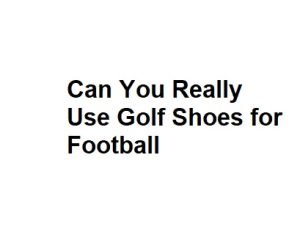Golf shoes and football cleats are two distinct types of athletic footwear designed for different purposes. While golf shoes are engineered to provide stability and traction on golf courses, football cleats are designed to offer grip and support for football players on the field. In this article, we’ll explore whether it’s possible to use golf shoes for football and the potential advantages and disadvantages of doing so.
Understanding Golf Shoes:
Golf shoes are primarily designed to provide stability during a golfer’s swing and walking on the golf course. They typically have a low-profile design with soft spikes or cleats on the outsole. The soft spikes help golfers maintain their balance during the golf swing while preventing damage to the greens.
Understanding Football Cleats:
Football cleats, on the other hand, are designed specifically for the demands of the football field. They feature longer, more aggressive cleats or studs to provide excellent traction on grass or turf surfaces. Football cleats are designed to help players make quick cuts, change directions, and generate power during sprints.
Advantages of Using Golf Shoes for Football:
- Comfort: Golf shoes tend to be more comfortable than football cleats due to their cushioned insoles and lightweight construction. This comfort can be advantageous, especially for recreational football games.
- Durability: Golf shoes are often made with durable materials that can withstand regular wear and tear. This durability may make them suitable for occasional football use.
Disadvantages of Using Golf Shoes for Football:
- Traction Issues: Golf shoes lack the aggressive traction needed for football maneuvers, such as quick cuts, pivots, and accelerations. This can lead to slips and falls on the field.
- Inadequate Ankle Support: Football cleats typically offer better ankle support due to their higher cut and design, which is essential for preventing ankle injuries during intense gameplay.
- Unintended Damage: The soft spikes on golf shoes can damage the football field’s grass or turf, potentially leading to concerns from field managers or league officials.
- Limited Performance: Using golf shoes for football can hinder your performance, especially in competitive or high-intensity matches where proper footwear is crucial.
Alternatives to Consider:
If you find yourself in a situation where you need an alternative to football cleats and don’t want to invest in a dedicated pair, here are some options to consider:
- Turf Shoes: Turf shoes are designed for use on artificial turf surfaces. They have shorter rubber studs that provide excellent traction without damaging the turf. While not ideal for natural grass fields, they offer a compromise between golf shoes and football cleats.
- Multi-Sport Cleats: Some athletic footwear brands offer multi-sport cleats designed for use in various sports, including football. These shoes typically have a more versatile outsole that can handle different playing surfaces and provide better traction than golf shoes.
- Cleat Covers: Cleat covers are rubber or silicone attachments that can be placed over your golf shoe’s spikes to provide additional grip. While these can improve traction to some extent, they may not offer the same level of performance and safety as dedicated football cleats.
- Borrow or Rent Football Cleats: If you only occasionally play football and don’t want to invest in football cleats, consider borrowing or renting a pair when needed. Many sports facilities and recreational leagues offer rental options for players.
Features of Golf Shoes for Football
| Feature | Grip | Comfort | Durability | Style |
|---|---|---|---|---|
| Golf Shoes | Excellent | Moderate | Good | Stylish |
| Football Shoes | Excellent | Excellent | Excellent | Varied Styles |
Key Differences between Golf Shoes and Football Shoes
| Criteria | Golf Shoes | Football Shoes |
|---|---|---|
| Sole Design | Spiked or Cleated | Cleated or Studs |
| Support | Minimal ankle support | High ankle support |
| Traction on Grass | Designed for fairways | Designed for turf or grass |
| Ball Control | Not designed for it | Designed for precise control |
| Weight | Lighter | Heavier |
Advantages of Using Golf Shoes for Football
| Advantage | Description |
|---|---|
| Comfort | Cushioned insoles provide comfort during play |
| Style | Stylish designs make a statement on the field |
| Versatility | Can be used for both golf and casual wear |
| Durability | Quality materials ensure longevity |
| Grip on Grass | Good traction on grass surfaces |
Disadvantages of Using Golf Shoes for Football
| Disadvantage | Description |
|---|---|
| Limited Ankle Support | Lacks the necessary ankle support for football |
| Traction on Turf | May not provide adequate traction on artificial turf |
| Ball Control | Not designed for precise ball control |
| Heavier Than Football Shoes | Golf shoes are typically lighter |
| Potential Damage to Cleats | Football-specific cleats can be damaged on golf courses |
Tips for Using Golf Shoes in Football
| Tip | Description |
|---|---|
| Choose Soft Ground | Use on natural grass fields for better traction |
| Consider Insole Support | Insert additional insoles for added comfort |
| Be Mindful of Ankle Support | Use an ankle brace if needed for extra support |
| Inspect and Clean Regularly | Keep shoes in good condition for longevity |
| Use as Backup | Use golf shoes for casual play, not as primary football footwear |
Final Thoughts:
In summary, while it is technically possible to use golf shoes for football, it is not the ideal or recommended choice due to potential traction, support, and field damage issues. To maximize your performance and safety on the football field, investing in proper football cleats is the best approach. If you must use an alternative, consider options like turf shoes or multi-sport cleats that are better suited for the demands of football gameplay while minimizing the risks associated with using golf shoes.



